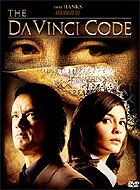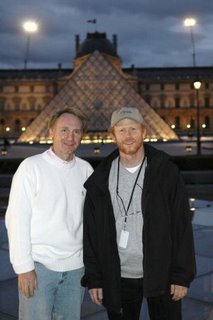 Last month, when I mentioned TDVC was coming out on DVD in a pricey special double-disc edition, I concluded it would not really sell well, not being much of a Xmas present due to its subject matter, and would probably soon come down in price. The double-disc edition is already being sold in the UK for under £10 by the Tesco supermarket chain (£13.99 on Amazon UK). Following up on this earlier item, which I based on a press release, here is a look at the actual 2-DVD set sold in the UK. The actual release varies in at least one major aspect. The 28 minutes of deleted scenes mentioned are not included on the 2-DVD Special Edition (running time 2 hrs 22 mins), only the Extended Edition. Even when you’ve added the 4% back on to compensate for the ‘PAL-speedup’ effect on Region 2 DVDs (where films shot at 24 frames/sec are scanned in at 25 fps), with the 2hr-22min Special Edition you’re just back up to the 149 minutes standard cinema release. The Extended Edition now lists only 22 (not 28) minutes of deleted scenes but has a 'Deleted Scenes' featurette. The IMDB site lists two running times: 149 mins and 167 mins for the “extended dvd edition” and their ‘DVD Details’ page lists an Extended Edition DVD release.
Last month, when I mentioned TDVC was coming out on DVD in a pricey special double-disc edition, I concluded it would not really sell well, not being much of a Xmas present due to its subject matter, and would probably soon come down in price. The double-disc edition is already being sold in the UK for under £10 by the Tesco supermarket chain (£13.99 on Amazon UK). Following up on this earlier item, which I based on a press release, here is a look at the actual 2-DVD set sold in the UK. The actual release varies in at least one major aspect. The 28 minutes of deleted scenes mentioned are not included on the 2-DVD Special Edition (running time 2 hrs 22 mins), only the Extended Edition. Even when you’ve added the 4% back on to compensate for the ‘PAL-speedup’ effect on Region 2 DVDs (where films shot at 24 frames/sec are scanned in at 25 fps), with the 2hr-22min Special Edition you’re just back up to the 149 minutes standard cinema release. The Extended Edition now lists only 22 (not 28) minutes of deleted scenes but has a 'Deleted Scenes' featurette. The IMDB site lists two running times: 149 mins and 167 mins for the “extended dvd edition” and their ‘DVD Details’ page lists an Extended Edition DVD release.As with other aspects of this film, they just couldn’t make up their mind, and there are in fact various editions released in various countries, on single or double discs. There are editions in widescreen or full-screen, and various box editions that come with a copy of the book, a model cryptex, and so on. The UK 2-disc Special Edition DVD-set is in 2.35:1 widescreen, and so is presumably the same as the US Region One “Widescreen Two-Disc Special Edition” in this respect. In France, they have the “Collector 2 DVD (Version longue). Le film avec 28 minutes de scènes supplémentaires exclusives + DVD bonus avec près de 2 heures de compléments.” Just to confuse the issue further, the IMDB says “A director's cut is available in DVD and is 15 minutes longer.“ (A recent Time magazine review mentions a 2hr 32 min length, which is exactly 15 minutes shorter than the 167 minute extended version mentioned.)
This is not just the usual film-buff issue where the ‘director’s cut’ is valued in itself, for the film has a major problem with cramming its exposition and melodramatic final religious revelations into even a 149-minute slot, with audiences left confused (in the case of Cannes film festival audiences, laughing in disbelief), especially in the final ten minutes. Restoring the 28 minutes of deleted scenes would probably have helped some aspects of this. Not re-issuing the film in extended form as the standard DVD release was probably a marketing mistake, especially after the usual precaution of sneak-preview audience-testing at the time of the cinema premiere was not followed. (Due to the film’s controversial nature and plot revelations, even the usual press screenings were banned).
Of the extras on Disc 2, these are the same featurette titles as previously listed here. One of them, the 'Bonus Previews' listed previously, are trailers for other Sony releases like Casino Royale and are actually on Disc 1. On Disc 2, some of the listed ‘featurettes’ are quite brief and inherently insubstantial – with the ‘Play All’ option, it’s apparent these are meant to be viewed as part of a single behind-the-scenes feature-length documentary, with the chapter divisions akin to the planned break-points in commercial TV programming. ‘First Day On The Set With Ron Howard’ shows some behind-the-cameras setups at the Louvre. 'The Music Of The Da Vinci Code’ disappoints (compare it to composer Hans Zimmer’s Gladiator-scoring DVD featurette), especially as there was music by others besides Zimmer, including a ‘Kyrie For Mary Magdalene’ by UK composer Richard Harvey and a piece allegedly by Dan Brown himself, and the film’s UK release was nearly delayed because the official censor felt the music and audio together were too frightening. ‘Close-up On Mona Lisa’ has nothing that is not familiar (the eyes follow you around the room etc). ‘The Codes Of The Da Vinci Code‘ has subtitles showing some visual references which were put in as ‘knowing’ art-director type references (i.e. that you wouldn’t even notice if you weren’t an art connoisseur) and most seem quite pointless when explained. None of the featurettes can claim to have any real substance content-wise. The fact the subject is somewhat controversial is only mentioned once in passing, in a dismissive way (an attitude the filmmakers may have later regretted – Hanks soon had to hire armed bodyguards to protect his family). All concerned stick to their promotional agendas about how exciting the project was for them, how they worked with some old faces and some new talent, and how exciting the finished film will be. The other items are longer, but all lack the punchiness of editing of Sony’s half-hour TV ‘the-making-of’ promo featurette done for the premiere, which did at least create a sense of excitement in itself, and could have been included here.
In ‘A Discussion With Dan Brown,’ the author is also billed as Executive Producer, and appears partly on the set at Roslyn Chapel wearing producer’s console headphones. In “A Portrait Of Langdon”, we hear from Dan Brown and Tom Hanks. Though Hanks was criticised as giving a dull performance, it’s easy to see why they wanted him – it’s hard to imagine the more conventional tough-guy Hollywood hero delivering that closing speech about believing in Jesus. (Though the dialogue coach should have explained to him ‘Templars’ is not pronounced Tem-PLARs, something that grates in the film for a supposed historical expert.) We get a bit more of Langdon’s PowerPoint presentation from the start, an addition to the book by scriptwriter Akiva Goldsman (who is, disappointingly, otherwise little to be heard from, though it’s mentioned in passing he was actually onset for quick dialogue rewrites). ‘Who Is Sophie Neveu?’ is potentially the most interesting, as one might hope for some insight into why Tautou seems so miscast, lost and colourless throughout. (The only clue seems to be they decided to have her as an actress with not too hard-bitten an image, using here as a pretty face, with no characterisation beyond childhood trauma, and given no chances to show off her cryptographic expertise so that she doesn’t upstage Hanks.) ‘Unusual Suspects’ is the most varied and fun, as it covers the supporting cast members in turn. ‘Magical Places’ looks at the filming at the Louvre and in London – at Temple Church, and on the streets of London (Gloucester Terrace, and in front of Westminster Abbey, where they weren’t allowed inside), plus Lincoln Cathedral (dressed as Westminster Abbey interior), Burghley House (as various country houses), and Rosslyn Chapel. The crew say that as well as filming in France and Malta, they filmed all over England and all over Scotland (there is no sign whatever of this in the film), and Ron Howard describes “Edinborough” as a very cool place. An aside mentions some Biblical flashbacks were shot on a 2nd-unit directors’ favourite UK standby location for desert scenes, a quarry at Leighton Buzzard.
 One disappointing omission is that there’s no featurette on a major factor in the film’s visual storytelling style - the CGI effects used to illustrate the decoding process and to cover location problems, as at St Sulpice (no permission to film) and Roslyn (in reality covered in scaffolding). These are also used in the large-scale flashback montage scenes done in desaturated colour. (These dramatically recreate the Crusaders’ assault on Jerusalem, the Christians’ toppling Roman pagan statuary, the suppression of the Templars, and the - equally unhistorical - rounding-up for burning of ‘millions’ of witches. All we see is a glimpse or two of the filming of a few foreground-action setups for these.) If you only watch a couple of these featurettes, select the 2-part “Filmmakers’ Journey/Experience”. This covers various aspects of the filming, and as a bonus, we get an explanation of the aspect that caused the most controversy with film critics (the ones who laughed at the religious revelations): Tom Hanks’ mullet-style hairdo. (It’s actually quite authentic among middle-aged American academics who teach communications and the like – I have to add I’ve seen this myself over the past few decades.) A final letdown is that there’s nothing on deleted scenes - not even any discussion of these in the Special Edition's Extras. Viewers would probably be better off seeking out the Extended Edition even if it’s a single disc with no Extras, with the deleted 20-odd minutes restored, in the hope the result would be more coherent. For reasons best known to Sony, the Extended Edition only seems to be available in Germany (via Amazon.de) and Australia.
One disappointing omission is that there’s no featurette on a major factor in the film’s visual storytelling style - the CGI effects used to illustrate the decoding process and to cover location problems, as at St Sulpice (no permission to film) and Roslyn (in reality covered in scaffolding). These are also used in the large-scale flashback montage scenes done in desaturated colour. (These dramatically recreate the Crusaders’ assault on Jerusalem, the Christians’ toppling Roman pagan statuary, the suppression of the Templars, and the - equally unhistorical - rounding-up for burning of ‘millions’ of witches. All we see is a glimpse or two of the filming of a few foreground-action setups for these.) If you only watch a couple of these featurettes, select the 2-part “Filmmakers’ Journey/Experience”. This covers various aspects of the filming, and as a bonus, we get an explanation of the aspect that caused the most controversy with film critics (the ones who laughed at the religious revelations): Tom Hanks’ mullet-style hairdo. (It’s actually quite authentic among middle-aged American academics who teach communications and the like – I have to add I’ve seen this myself over the past few decades.) A final letdown is that there’s nothing on deleted scenes - not even any discussion of these in the Special Edition's Extras. Viewers would probably be better off seeking out the Extended Edition even if it’s a single disc with no Extras, with the deleted 20-odd minutes restored, in the hope the result would be more coherent. For reasons best known to Sony, the Extended Edition only seems to be available in Germany (via Amazon.de) and Australia.





